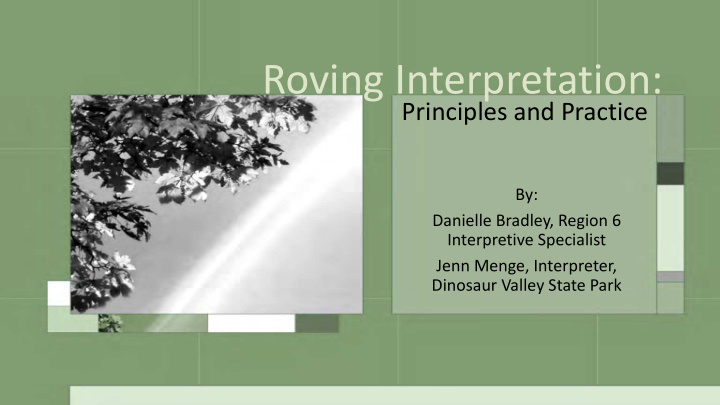



Roving Interpretation: Principles and Practice By: Danielle Bradley, Region 6 Interpretive Specialist Jenn Menge, Interpreter, Dinosaur Valley State Park
Roving Interpretation: What is it? Cover Bradley’s 7 principles of Roving Interpretation How do we do it? Jenn share’s real-life examples of roving How can YOU do it? Brainstorming activity to get you prepared to rove at your site
What is Roving Interpretation? Planned, personalized Roving Interpretation is: communication with the Planned, visitor in an informal setting Personalized Audience – venue Resource – stage Interpreter - catalyst
Bradley’s 7 Principles of Roving Interpretation Seven basic principles Helps interpreter prepare for roving interp Created by me, Danielle Bradley! Inspired by Tilden’s 6 principles of interpretation
1. Roving interpretation is organized and planned in advance. Good roving should feel Great opportunity to capitalize spontaneous on seasonal events Should plan for: What items would you put in a general kit bag? Location Visitor Needs Any props
2. Roving should be scheduled. Important for two reasons: Schedule during peak times for maximum Ensures you’ll make the time contact/exposure for it Gives added emphasis that you’ll spend one-on-one time with visitor
3. The benefits of roving interpretation extend beyond the visitor. Visitor Benefits: Public Relations Benefits: Can address safety concerns Pure joy for interpreter Good face time with visitors Resource Benefits: Valuable Knowledge Benefits: Gain compliance via understanding Gain insight to audience who What are some commonly aren’t coming to programs broken rules at your site? What other benefits can you think of?
4. Roving interpretation reaches new audiences. Only ~20% of visitors attend By roving through trails, interp. programs campgrounds, and day use areas: Creates personalized discovery Personally invite visitors to opportunities for the visitor programs Gain valuable insight about visitors and program audience
5. The more you know the location, the better the discoveries. An in-depth knowledge of More you visit a site, the more your location helps the visitor discoveries you make make discoveries about your Speed up those discoveries for site your visitor What are some potential Look at each location from the roving locations at your site? perspective of: Management Interpreter Parent/child
6. Plan for the less-obvious curiosities of the visitor. Most important thing to plan Remember , no matter how for. many times you’ve heard a question, this is the visitor’s Experience is the best teacher first time asking it. for this. You’ve selected a location because it attracts visitors Ask yourself what is it that brings them to this site?
7. Continually assess your audience. Be observant so you can Keep an eye out for clues the customize the interaction to contact should end: the individual What are some clues to look for? What clues do you look for? (either positive or negative) Disengaging with a visitor Use tactful persuasion and skill Direct them to a trail, or feature they may enjoy What methods do you use?
Principles into Practice Sounds great in theory… But what about in real life??
Examples in the field Information tables Roving by park features Roving trails Roving with props Scheduled roving
Roving table/Touch table Easily set up and moved table Can be placed where most visitors are located at that time Include tactile objects Furs, skulls, live specimens (use good judgment), plant IDs, etc. Great way to educate, inform, answer questions, and direct visitors to other areas Use clicker to count contacts Other things – maps, stickers, Jr. Ranger books, Jr. Ranger badges
Roving by a park feature
Roving trails Interpretation/education Visitor safety and orientation Resource protection Knowledge of what’s in your park and what’s seasonal Bring backpack with maps, first aid, radio, extra water/snacks
Roving with a prop
Scheduled roving Supervisors: Schedule 1-2 hour blocks for employees/interpreters Put volunteers on roving duty Interpreters Set aside 1-2 hour blocks for yourself Pick what type of roving you will focus on depending on weather, visitation, etc.
Supporting roving interpretation Talking with supervisors – go over principles and importance of roving Count and report roving contacts to justify roving If supervisor is unsupportive of one type of roving, offer another type in its place ex. supervisor doesn’t want you out on trails, offer to set up information table somewhere instead
Brainstorming Let’s think about roving at your site: Location Season Kit Bags
Questions? Danielle Bradley Jenn Menge Danielle.Bradley@tpwd.texas. Jenn.Menge@tpwd.texas.gov gov 903-216-4402
Recommend
More recommend